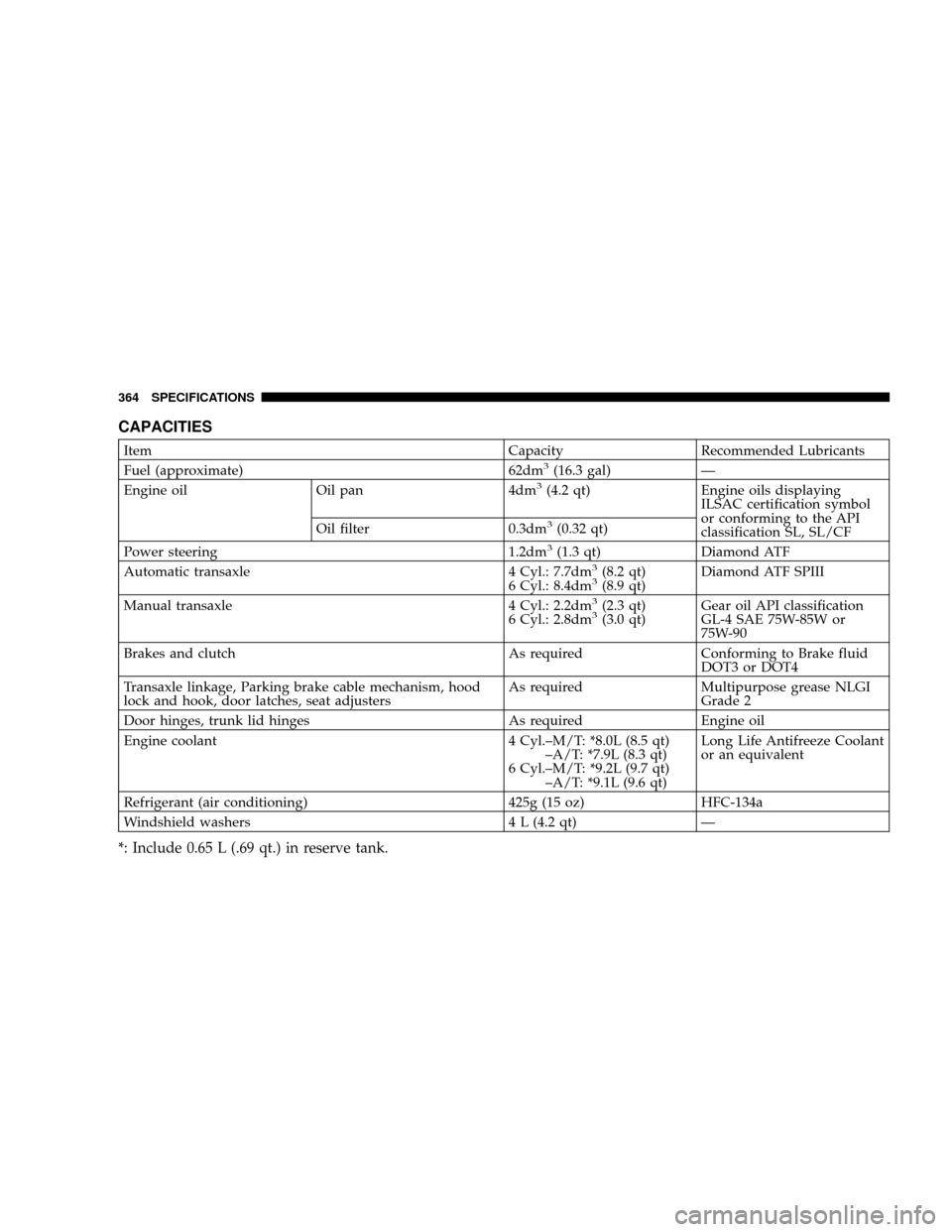Page 142 of 382

BREAK-IN RECOMMENDATIONS
Advanced automobile manufacturing techniques permit
you to operate your new vehicle without experiencing a
long break-in period of low-speed driving.
However, you can add to the future performance and
economy of your vehicle by observing the following
precautions during the first 300 miles (500 km).
It is recommended that you drive your vehicle at mod-
erate speeds during the break-in period.
1. Avoid racing the engine.
2. Avoid harsh driving such as fast starts, sudden accel-
eration, prolonged high-speed driving and abrupt appli-
cation of the brakes. These operations not only have a
detrimental effect on the engine but also cause increased
fuel and oil consumption, which could result in malfunc-
tion of engine components. Be particularly careful to
avoid wide-open throttle acceleration in low gear.
3. Do not overload the vehicle. Observe the seating
capacity. (See ªWeightsº page 359)
4. Do not use this vehicle for trailer towing during the
break-in period.
FUEL SELECTION
Your vehicle is designed to use unleaded gasoline only. It
is equipped with a fuel filler tube especially designed to
accept only the smaller diameter unleaded gasoline dis-
pensing nozzle.
WARNING!
Gasoline is highly flammable and explosive. You can
be burned or seriously injured when handling it.
When refueling this vehicle, always turn the engine
off and keep flames, sparks, and smoking materials
away. Always handle fuel in well-ventilated outdoor
areas.
142 STARTING AND DRIVING
Page 200 of 382

over curbs or parking stop blocks. Always use caution
when traveling up or down sharp inclines as your
bumper may contact the road surface.
2. Maintain specified tire inflation pressures. Replace
tires before they are excessively worn.
3. If you plan to drive in another country, comply with
the vehicle registration laws and confirm the availability
of the correct fuel.
OPERATION DURING COLD WEATHER
1. Check the battery, including terminals and cables.
During extremely cold weather, the battery capacity will
decrease. Also, the battery power level may drop because
more power is needed for cold starting and operation.
Before driving the vehicle, check to see if the engine runs
at the proper speed and if the headlights are at their usual
intensity. Charge or replace the battery if necessary.
During cold weather, it is possible that a discharged
battery could freeze.
WARNING!
The battery gives off explosive hydrogen gas. Any
spark or flame can cause the battery to explode,
which could seriously injury or kill you.
Always wear protective clothes and a face shield
when doing battery maintenance, or let a skilled
technician do it.
2. Manual transaxles may be more difficult to shift
during cold weather operation. This is normal and shift
effort will become easier as the transaxle reaches a
normal operating temperature.
Maintain low-speed operation at first to allow the trans-
axle oil to be distributed to all lubrication points.
3. Check the engine antifreeze.
If there is a shortage of coolant due to leakage or engine
overheating, add high-quality ethylene glycol antifreeze
and water. The recommended ratio is about 50% water
and 50% anti-freeze. This ratio provides adequate corro-
sion, boiling, and freeze protection.
200 STARTING AND DRIVING
Page 288 of 382
5. Insert a new fuse of the same capacity securely into the
fuse block location.
CAUTION!
²Never use a fuse with a capacity larger than that
specified or any substitute, such as wire, foil, etc.
Doing so will cause the circuit wiring to heat up
and could cause a fire.
²If the newly inserted fuse blows again after a
short time, have the electrical system checked by
an authorized dealer to find and correct the cause.
REPLACEMENT OF LIGHT BULBS
Before replacing a bulb, be sure the light is off. Do not
touch the glass part of the new bulb with your bare
fingers; the skin oil left on the glass will evaporate when
the bulb gets hot and the vapor will condense on the
reflector and dim the surface.
Bulb capacity
A bulb should only be replaced with a new bulb of the
same rating and type. The designation can be found on
the base of the bulb.
N29C0010
288 EMERGENCIES
Page 364 of 382

CAPACITIES
Item Capacity Recommended Lubricants
Fuel (approximate) 62dm3(16.3 gal) Ð
Engine oil Oil pan 4dm3(4.2 qt) Engine oils displaying
ILSAC certification symbol
or conforming to the API
classification SL, SL/CF Oil filter 0.3dm
3(0.32 qt)
Power steering 1.2dm
3(1.3 qt) Diamond ATF
Automatic transaxle 4 Cyl.: 7.7dm3(8.2 qt)
6 Cyl.: 8.4dm3(8.9 qt)Diamond ATF SPIII
Manual transaxle 4 Cyl.: 2.2dm3(2.3 qt)
6 Cyl.: 2.8dm3(3.0 qt)Gear oil API classification
GL-4 SAE 75W-85W or
75W-90
Brakes and clutch As required Conforming to Brake fluid
DOT3 or DOT4
Transaxle linkage, Parking brake cable mechanism, hood
lock and hook, door latches, seat adjustersAs required Multipurpose grease NLGI
Grade 2
Door hinges, trunk lid hinges As required Engine oil
Engine coolant 4 Cyl.±M/T: *8.0L (8.5 qt)
±A/T: *7.9L (8.3 qt)
6 Cyl.±M/T: *9.2L (9.7 qt)
±A/T: *9.1L (9.6 qt)Long Life Antifreeze Coolant
or an equivalent
Refrigerant (air conditioning) 425g (15 oz) HFC-134a
Windshield washers 4 L (4.2 qt) Ð
*: Include 0.65 L (.69 qt.) in reserve tank.
364 SPECIFICATIONS
Page 379 of 382

Dimmer............................ 120
Headlight flasher (high/low beam)........ 119
Switch............................. 118
Heater............................... 234
High beam indicator..................105,110
High-mounted stoplights
Bulb capacity........................ 288
Homelink Transmitter................... 130
Horn switch........................... 130
Ignition switch......................... 147
Indicator and warning light............... 105
Inside day/night rearview mirrors.......... 175
Instrument cluster...................... 104
Instrument panel light dimmer control....... 123
Intermittent Wipers..................... 125
Jack
Jacking points........................ 266
Jacking up the car..................... 266
Storage............................. 262
Key reminder chime..................... 148Keyless entry system..................... 29
Keys..............................23,148
Labeling............................. 358
Lap Belts.............................. 85
Lights
Bulb chart........................... 289
Dome light/Reading light............... 127
Headlights.......................... 118
Reading lamps....................... 129
Low-fuel warning light................105,111
Luggage hooks......................... 213
Malfunction Indicator Light............... 308
Manual, Service........................ 371
Manual transaxle
Oil ................................ 323
Possible driving speed................. 167
Shift points (recommended speed)........ 165
Meters............................... 104
Mirrors
Vanity mirror........................ 209
Mopar Parts........................309,369
INDEX 379